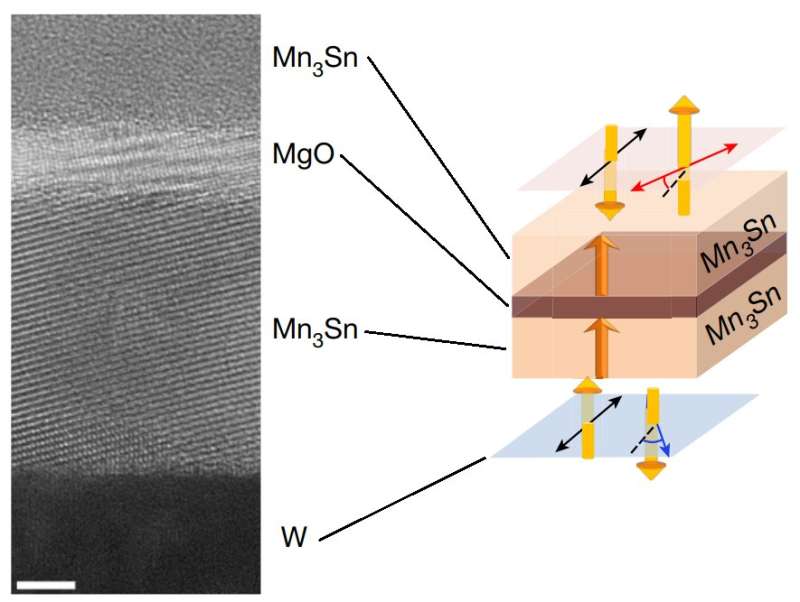Approaching the terahertz regime: Room temperature quantum magnets switch states trillions of times per second

A class of nonvolatile memory devices, called MRAM, based on quantum magnetic materials, can offer a thousandfold performance beyond current state-of-the-art memory devices. The materials known as antiferromagnets were previously demonstrated to store stable memory states, but were difficult to read from. This new study, now published in Nature, paves an efficient way for reading the memory states, with the potential to do so incredibly quickly too.
You can probably blink about four times a second. You could say this frequency of blinking is 4 hertz (cycles per second). Imagine trying to blink 1 billion times a second, or at 1 gigahertz, it would be physically impossible for a human. But this is the current order of magnitude in which contemporary high-end digital devices, such as magnetic memory, switch their states as operations are performed. And many people wish to push the boundary a thousand times further, into the regime of a trillion times a second, or terahertz.
The barrier for realizing faster memory devices may be the materials used. Current high-speed MRAM chips, which aren’t yet so common as to appear in your home computer, make use of typical magnetic, or ferromagnetic, materials. These are read using a technique called tunneling magnetoresistance. This requires the magnetic constituents of ferromagnetic material to be lined up in parallel arrangements. However, this arrangement creates a strong magnetic field which limits the speed at which the memory can be read from or written to.
“We’ve made an experimental breakthrough that surpasses this limitation, and it’s thanks to a different kind of material, antiferromagnets,” said Professor Satoru Nakatsuji from the University of Tokyo’s Department of Physics.
“Antiferromagnets differ from typical magnets in many ways, but in particular, we can arrange them in ways other than parallel lines. This means we can negate the magnetic field that would result from parallel arrangements. It’s thought that the magnetization of ferromagnets is necessary for tunneling magnetoresistance to read from memory. Strikingly, however, we found it’s also possible for a special class of antiferromagnets without magnetization, and hopefully it can perform at very high speeds.”
Nakatsuji and his team think that switching speeds in the terahertz range is achievable, and that this is possible at room temperature too, whereas previous attempts required much colder temperatures and did not yield such promising results. Though, to improve upon its idea, the team needs to refine its devices, and improving the way it fabricates them is key.
“Although the atomic constituents of our materials are fairly familiar—manganese, magnesium, tin, oxygen, and so on—the way in which we combine them to form a useable memory component is novel and unfamiliar,” said researcher Xianzhe Chen.
“We grow crystals in a vacuum, in incredibly fine layers using two processes called molecular beam epitaxy and magnetron sputtering. The higher the vacuum, the purer the samples we can grow. It’s an extremely challenging procedure and if we improve it, we will make our lives easier and produce more effective devices too.”
These antiferromagnetic memory devices exploit a quantum phenomenon known as entanglement, or interaction at a distance. But despite this, this research is not directly related to the increasingly famous field of quantum computing. However, researchers suggest that developments such as this might be useful or even essential to build a bridge between the current paradigm of electronic computing and the emerging field of quantum computers.
More information:
Xianzhe Chen et al, Octupole-driven magnetoresistance in an antiferromagnetic tunnel junction, Nature (2023). DOI: 10.1038/s41586-022-05463-w
Citation:
Approaching the terahertz regime: Room temperature quantum magnets switch states trillions of times per second (2023, January 19)
retrieved 19 January 2023
from https://phys.org/news/2023-01-approaching-terahertz-regime-room-temperature.html
This document is subject to copyright. Apart from any fair dealing for the purpose of private study or research, no
part may be reproduced without the written permission. The content is provided for information purposes only.
For all the latest Science News Click Here
For the latest news and updates, follow us on Google News.

